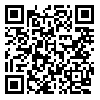1. Burke TJ, Woszidlo A, Segrin C. Social skills, family conflict, and loneliness in families. Communication Reports. 2012;25(2):75–87. [
DOI]
2. Deming DJ. The growing importance of social skills in the labor market. Journal of Economics. 2017;132(4):1593–640. [
DOI]
3. de Boer A, Peeters M, Koning I. An experimental study of risk-taking behavior among adolescents: A closer look at peer and sex influences. The Journal of Early Adolescence. 2017 Oct;37(8):1125-41. [
DOI]
4. Habibpour K. The Pattern of Smoking among a Sample of Tehranian Citizens. Journal of social problem of Iran. 2020;10(2):85-109.[Persian] [
Article]
5. Jebraeili H, Felegari M. Analyzing the Patterns of Multiple Substance Use and Risky Sexual Behavior and the Protective Role of Religious Faith in College Students. Etiad Pajohi. 2020;15 (62):341-359. [
Article]
6. Rezaei R, Noori N, Rezaei A, Fotoohi A, Mohammadvali A. The relationship between the manners of parenting by parents and the extent of anxiety among the students. Chronic Diseases Journal. 2018;6(2):78–81. [Persian] [
DOI]
7. Laursen B, DeLay D, Richmond A, Rubin KH. Youth negative affect attenuates associations between compromise and mother–adolescent conflict outcomes. J Child Fam Stud. 2016;25(4):1110–8. [
DOI]
8. Smokowski PR, Bacallao ML, Cotter KL, Evans CBR. The effects of positive and negative parenting practices on adolescent mental health outcomes in a multicultural sample of rural youth. Child Psychiatry Hum Dev. 2015;46(3):333–45. [
DOI]
9. Terzian MA, Andrews KM, Moore KA. Preventing multiple risky behaviors among adolescents: Seven strategies. Child Trends. 2011;24:1–12.
10. Tomé G, Matos M, Simões C, Diniz JA, Camacho I. How can peer group influence the behavior of adolescents: explanatory model. Glob J Health Sci. 2012;4(2):26–35. [
DOI]
11. Arabnejad Shadi A, Mafahkeri A, Ranjbar MJ. The role of family cohesion and self-worth in predicting tendency towards risky behavior in adolescents. Journal of psychology studies. 2018;14(1): 147-62. [Persian]
12. Alimoradi Z, Kariman N, Ahmadi F, Simbar M. Preparation for sexual and reproductive self-care in Iranian adolescent girls: a qualitative study. International Journal of Adolescent Medicine and Health. 2018;30(1):22–34. [
DOI]
13. Jurevičienė M, Kaffemaniene I, Irena Ruškus J. Concept and Structural Components of Social Skills. Baltic Journal of Sport and Health Sciences. 2018; 3(86). [
DOI]
14. Hilliard ME, Holmes CS, Chen R, Maher K, Robinson E, Streisand R. Disentangling the roles of parental monitoring and family conflict in adolescents’ management of type 1 diabetes. Health Psychology. 2013;32(4):388–96. [
DOI]
15. Nagle DW, Hansen DJ. Relations between social skills and high-risk sexual interactions among adolescents. Behavior Modification. 1993;17:113-35. [
DOI]
16. Khodaei H, Fathi A, Alipour R. Effectiveness of Social Skills Training in the High-risk Behaviors and Communication Skills of Secondary School Students. J Research Health 2021; 11 (3) :175-182. [
Article]
17. Asghari F, Sadeghi A, Ghasemi Jobaneh R, Dargahi S. Role of Parental Monitoring and Self- Efficacy in Affiliation with Delinquents Peers and High-Risk Behaviors of High School Students. Criminal Law Research. 2015; 6(2): 33-48. [Persian]
18. Byrne BM. Structural Equation Modeling With AMOS: Basic Concepts, Applications, and Programming. Third Edition (3rd ed.). Routledge; 2016. [
DOI]
19. Lawshe CH. A quantitative approach to content validity. Personnel Psychology. 1975;28(4):563–75. [
DOI]
20. Robin AL, Foster SL. Negotiating parent-adolescent conflict: a behavioral-family systems approach. London: Guilford Press; 2002.
21. Firoozabady EE, Zarch MK, Afshani SA, Halvani A. The prevalence of sleep disorders and their relationship with anxiety and behavioral problems among primary school students in Yazd, Iran. Int J Pediatr. 2015;3(3–1):625–31. [
DOI]
22. Gresham FM, Elliott SN. Social skills rating system manual. Circle Pines, MN: American Guidance Service;1990.
23. Abbasi Asfjir A, Khatibi F. The standardize Social Skills Rating System for Parents and Teachers, Preschool Level (SSRS-PT) Gresham & Elliott in AMOl. PSYCHOMETRY. 2016; 5(17): 77-96.
24. Kelishadi R, Esmaeil Motlagh M, Rajaei L, Massoudi S, Ardalan G, Roudbari M, et al. Needs assessment for health status and self-care ability of youths aged 18-29 years in selected provinces of Iran. Journal of Health and Care. 2017;19(2):152–68. [Persian] [
Article]
25. Mohammad Eini Z, Sadeghi J, Dortaj F, Homayouni A. Structural Modeling of the Relationship between Parent-Adolescent Conflict and Aggression through the Mediating Role of Perceived Self-Control. Qom Univ Med Sci J. 2020; 14 (10) :66-75. [
DOI]
26. Farzaneh Jajarmi H, Sotodeh Asl N, Kohsari R, Jahan F. Presenting a Causal Model of Tendency to High-Risk Behaviors Based on Religious Attitude and Parental Parenting Styles: Mediated by Time Vision. Quarterly Social Psychology Research. 2021; 11(42): 35-52. [
DOI]
27. Smokowski PR, Bacallao ML, Cotter KL, Evans CB. The effects of positive and negative parenting practices on adolescent mental health outcomes in a multicultural sample of rural youth. Child Psychiatry & Human Development. 2015 Jun;46(3):333-45.
28. .Farzaneh S, Molania S, Zamani Rad E. A Survey of Family Factors Affecting 12-18 years old Teenager's Attitude towards Delinquency in Department of Correction and Rehabilitation of Gorgan City. Sociological Studies of Youth. 2017; 6(18): 73-89.
29. Ahamdi A, Saberi SM, Pournaghash tTehrani S, Arjmandnia AA. The Effect of Family Functioning on the Incidence of Delinquency in adolescents in Tehran Correctional Center. Knowledge & Research in Applied Psychology. 2021; 21(4): 95-102. [
DOI]
30. Burke J. Woszidlo A, Chris S. Social Skills, Family Conflict, and Loneliness in Families. Communication Reports. 2012. 25(2):75-87. [
DOI]

 ، نعمت ستوده اصل*2
، نعمت ستوده اصل*2 
 ، فائزه جهان3
، فائزه جهان3 
 ، علی اصغر فیروزجائیان4
، علی اصغر فیروزجائیان4 






